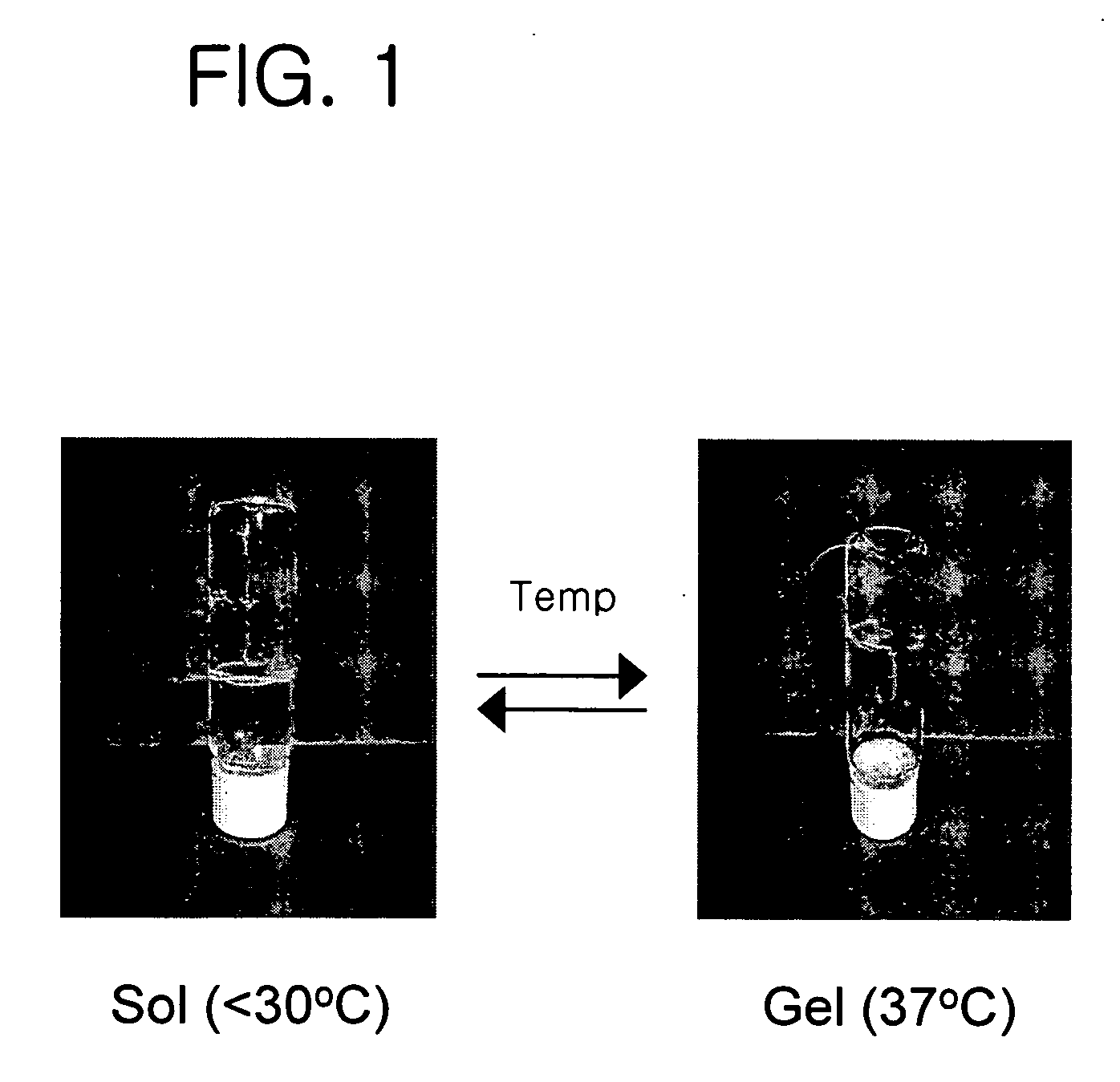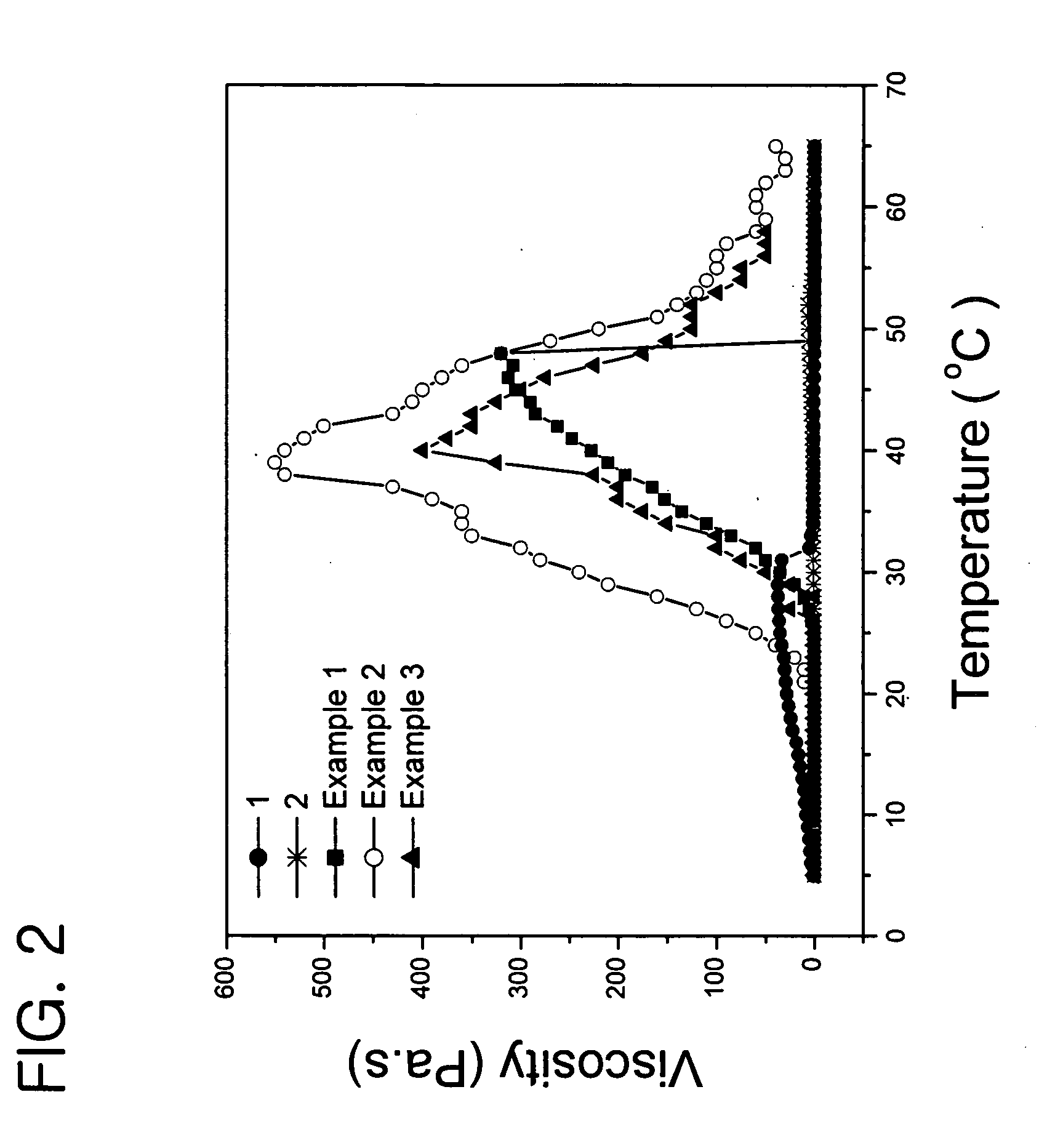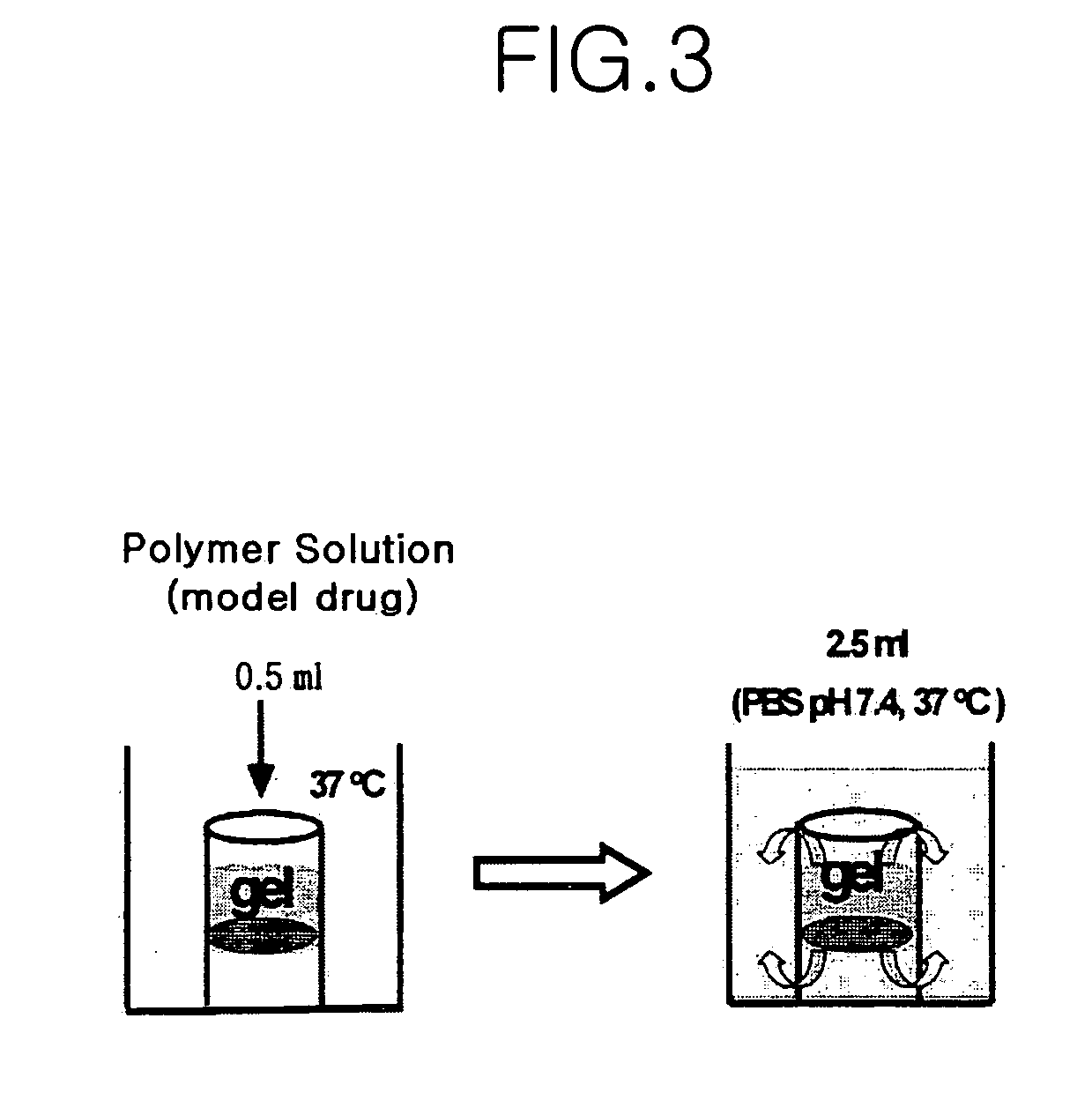Thermosensitive poly (organophosphazenes), preparation method thereof and injectable thermosensitive polyphosphazene hydrogels using the same
a thermosensitive polyphosphazene and hydrogel technology, applied in the field of thermosensitive poly (organophosphazenes), can solve the problems of inability to be applied as a drug delivering material, inconvenient preparation, cytotoxic and insoluble, etc., and achieve excellent gel characteristics.
- Summary
- Abstract
- Description
- Claims
- Application Information
AI Technical Summary
Benefits of technology
Problems solved by technology
Method used
Image
Examples
example 1
Preparation of Poly[poly(aminomethoxyethyleneglycol550)(isoleucineethylester)(ethyl-2-(O-glycyl)lactate)], [NP(AMPEG550)0.78(IleOEt)1.18(GlyLacOEt)0.04]
Poly(dichlorophosphazene) (2.00 g, 17.26 mmol) was dissolved in tetrahydrofuran and then put into a dry ice-aceton bath. Then, triethylamine (8.38 g, 82.84 mmol) and isoleucineethylester hydrogen chloride salt (4.05 g, 20.71 mmol) were sequentially added thereto and reacted for 48 hours at room temperature.
To the above reaction solution, a solution of ethyl-2-(O-glycyl)lactate ammonium oxalate (0.152 g, 0.69 mmol) and triethylamine (0.35 g, 3.45 mmol) in acetonitrile (50 ml) was added, and then reacted for 19 hours in ice bath.
Then, poly(aminomethoxyethyleneglycol) (14.24 g, 25.89 mmol) having molecular weight of 550 and triethylamine (5.24 g, 51.78 mmol) were added thereto, and reacted for 48 hours at 50° C.
The reaction solution was centrifuged or filtered to remove an excess amount of precipitates (Et3N.HCl), and the filtrat...
example 2
Preparation of Poly[poly(aminomethoxyethyleneglycol550)(isoleucineethylester)(glycylgly-cinethylester)phosphazene], [NP(AMPEG550)0.70(IleOEt)1.20(GlyGIyOEt)0.10]
By the same method as that of Example 1, poly(dichlorophosphazene) (2.00 g, 17.26 mmol), triethylamine (4.19 g, 41.42 mmol) and isoleucineethylester hydrogen chloride salt (4.05 g, 20.71 mmol) in the first step, glycylglycinethylester hydrogen chloride salt (0.34 g, 1.73 mmol) and triethylamine (0.70 g, 6.92 mmol) in the second step, and poly(aminomethoxyethyleneglycol) (13.29 g, 24.16 mmol) of a molecular weight of 550 and triethylamine (4.89 g, 48.32 mmol) in the third step were respectively used for reaction, thereby obtaining 8.2 g (70% yield) of a final product, [NP(AMPEG550)0.70(IleOEt)1.20(GlyGlyOEt)0.10].
Composition formula: C37H75N4O16P
Elemental analysis: C, 50.01; H, 8.59; N, 6.90
Theoretical value: C, 49.80; H, 8.56; N, 6.84
Hydrogen NMR spectrum (CDCl3, ppm):
δ 0.8-1.0 (b, 6H, —NHCH(CH2CH(CH3)2COOCH2CH3), ...
example 3
Preparation of Polylpoly(aminomethoxyethyleneglycol550)(isoleucineethylester)phosphazene], [NP(AMPEG550)0.80(IleOEt)1.20]
Poly(dichlorophosphazene) (2.00 g, 17.26 mmol) was dissolved in THF and then put into a dry ice-aceton bath, then isoleucineethylester hydrogen chloride salt (4.05 g, 20.71 mmol) and triethylamine (8.38 g, 82.84 mmol) were sequentially added thereto and reacted for 48 hours at room temperature. Then, poly(aminomethoxyethyleneglycol) (15.19 g, 27.62 mmol) having a molecular weight of 550 and triethylamine (5.59 g, 55.24 mmol) were added thereto and reacted for 48 hours at 50° C.
The product was recovered from the reaction solution by the same method as described in Example 1, thereby obtaining 7.2 g (62% yield) of a final product, [NP(AMPEG550)0.80(IleOEt)1.20].
Composition formula: C31H64N3O13P
Elemental analysis: C, 50.45; H, 8.90; N, 6.38
Theoretical value: C, 49.95; H, 8.62; N, 6.24
Hydrogen NMR spectrum(CDCl3, ppm):
δ 0.8-1.0 (b, 6H, —NHCH(CH2CH(CH3)2COO...
PUM
| Property | Measurement | Unit |
|---|---|---|
| Time | aaaaa | aaaaa |
| Percent by mass | aaaaa | aaaaa |
| Equivalent mass | aaaaa | aaaaa |
Abstract
Description
Claims
Application Information
 Login to View More
Login to View More - R&D
- Intellectual Property
- Life Sciences
- Materials
- Tech Scout
- Unparalleled Data Quality
- Higher Quality Content
- 60% Fewer Hallucinations
Browse by: Latest US Patents, China's latest patents, Technical Efficacy Thesaurus, Application Domain, Technology Topic, Popular Technical Reports.
© 2025 PatSnap. All rights reserved.Legal|Privacy policy|Modern Slavery Act Transparency Statement|Sitemap|About US| Contact US: help@patsnap.com



